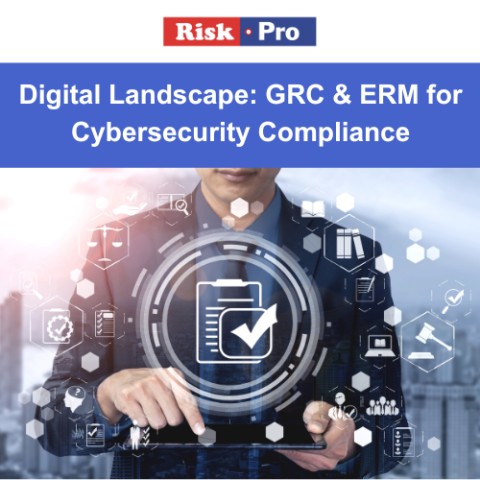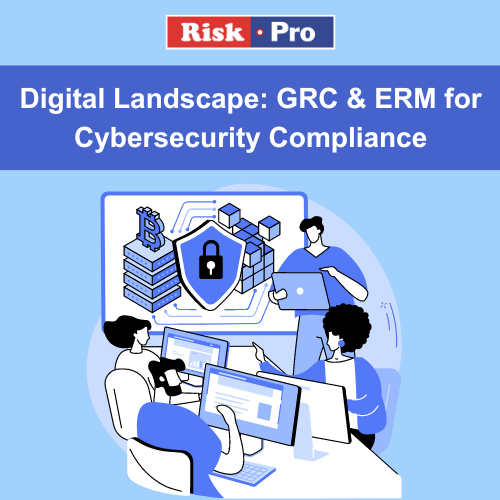
In today's fast-paced digital era, where technology advancements are at the forefront of ERM Frameworks.
Risk Assessment organizational operations, ensuring compliance with cybersecurity regulations has become more critical than ever. As businesses continue to digitize their processes, the need for robust Governance, Risk Management, and Compliance (GRC) strategies, coupled with effective Enterprise Risk Management (ERM) frameworks, is paramount. In this blog post, we'll explore the essentials of GRC and ERM, and how they play a pivotal role in safeguarding organizations against cyber threats.
Understanding the Basics: Governance, Risk Management, and Compliance (GRC)
Governance, Risk Management, and Compliance, often abbreviated as GRC, form the foundation for an organization's ability to navigate the complex regulatory landscape and manage potential risks effectively. Let's break down each component:
-
Governance: Governance refers to the system of rules, practices, and processes by which an organization is directed and controlled. It involves defining responsibilities, ensuring accountability, and establishing effective communication channels.
-
Risk Management: Risk management is the process of identifying, assessing, and prioritizing risks to minimize their impact on an organization's objectives. This involves understanding potential threats, vulnerabilities, and the likelihood of adverse events occurring.
-
Compliance: Compliance involves adhering to legal and regulatory requirements relevant to an organization's industry. It ensures that businesses operate within the boundaries set by laws, standards, and guidelines.
The Power of Integrated GRC
Integrated GRC is the synergy of these three components, providing a holistic approach to managing governance, risk, and compliance within an organization. Rather than treating each aspect in isolation, integrated GRC enables a more streamlined and efficient process, fostering a proactive rather than reactive stance towards compliance and risk management.
Navigating the Regulatory Maze: Regulatory Compliance and GRC Software
Regulatory compliance is a critical aspect of GRC that involves adhering to specific laws and regulations applicable to an organization's industry. With the ever-evolving regulatory landscape, staying compliant is a constant challenge.
Utilizing GRC software can significantly simplify the compliance journey. These tools provide a centralized platform for managing compliance requirements, automating tasks, and ensuring timely adherence to changing regulations. The result is a more efficient and transparent compliance process, reducing the risk of penalties and legal consequences.
Assessing Risks: Risk Assessment and Audit Management
Risk assessment is a key element of effective risk management. It involves identifying potential risks, evaluating their potential impact, and prioritizing them based on their likelihood and severity. This proactive approach allows organizations to allocate resources strategically to mitigate high-priority risks.
Audit management is closely tied to risk assessment, focusing on the systematic examination of processes, controls, and documentation to ensure compliance and identify areas for improvement. GRC tools often include features for streamlined audit management, enhancing the efficiency and effectiveness of the audit process.
Managing External Dependencies: Third-Party Risk Management and Vendor Risk Assessment
As organizations increasingly rely on external partners and vendors for various services, managing third-party risks becomes crucial. A breach in a vendor's security can have cascading effects on the organization.
Implementing a robust third-party risk management program involves conducting thorough vendor risk assessments. This process evaluates the security measures, data protection practices, and overall risk posture of external partners. By identifying potential risks early on, organizations can take preventive measures to safeguard their operations.
Holistic Frameworks for Enterprise Risk Management (ERM)
Enterprise Risk Management (ERM) takes a broader view of risks, encompassing risks across the entire organization. This proactive approach involves the identification, assessment, and management of risks that could impact the achievement of organizational objectives.
Key Components of ERM: Key Risk Indicators (KRIs) and Strategic Risk Management
Key Risk Indicators (KRIs) are quantifiable measurements used to monitor the potential impact of specific risks on organizational objectives. By tracking KRIs, organizations can detect emerging risks and take corrective actions before they escalate.
Strategic risk management, an integral part of ERM, involves aligning risk management practices with the overall strategic goals of the organization. This ensures that risk management becomes an enabler rather than a hindrance to achieving business objectives.
ERM Frameworks: A Blueprint for Risk Governance and Communication
Effective risk governance is central to the success of any ERM initiative. This involves establishing clear roles, responsibilities, and communication channels for managing risks throughout the organization.
ERM frameworks provide a structured approach to risk governance, offering guidelines for risk identification, assessment, response, and monitoring. By adopting a standardized framework, organizations can enhance their risk communication, ensuring that all stakeholders are informed and aligned in their approach to risk management.

Diverse Dimensions of Risk: Operational, ESG, and Supply Chain Risk Management
-
Operational Risk Management: Operational risks arise from internal processes, systems, people, and external events. An effective ERM strategy includes robust operational risk management to ensure the smooth functioning of day-to-day activities.
-
Environmental, Social, and Governance (ESG) Risk: With an increasing focus on sustainability and corporate responsibility, organizations need to address ESG risks. These risks involve factors related to environmental impact, social responsibility, and governance practices.
-
Supply Chain Risk Management: The interconnected global economy makes supply chain vulnerabilities a significant concern. ERM strategies should extend to supply chain risk management, identifying potential disruptions and implementing measures to ensure continuity.
Transparency Through Risk Reporting: A Pillar of Effective Risk Management
Transparent and comprehensive risk reporting is a cornerstone of effective risk management. By regularly communicating risk-related information to stakeholders, organizations foster a culture of accountability and awareness.
GRC software often includes features for customizable risk reporting, allowing organizations to tailor reports to the specific needs of different stakeholders. This transparency not only satisfies regulatory requirements but also enhances the organization's ability to make informed decisions based on risk insights.
RiskPro India Ventures Private Limited: Your Partner in Comprehensive Risk Management Solutions
In the dynamic landscape of digital business, partnering with a reliable risk management solutions provider is essential. RiskPro India Ventures Private Limited emerges as a trusted ally, offering a range of services to bolster your organization's GRC and ERM efforts.
-
GRC Software Solutions: Leveraging cutting-edge GRC software, RiskPro India provides customizable solutions tailored to your organization's unique needs. From regulatory compliance to risk assessment and audit management, the software streamlines processes, saving time and resources.
-
Third-Party Risk Management Expertise: With a deep understanding of the risks associated with external partnerships, RiskPro India assists in conducting thorough vendor risk assessments. By identifying and mitigating potential risks posed by third parties, your organization can fortify its defenses against cyber threats.
-
ERM Framework Implementation: RiskPro India guides organizations in establishing and implementing robust ERM frameworks. By aligning risk management practices with strategic objectives, the company ensures a comprehensive approach to identifying, assessing, and managing risks across all dimensions.
-
Bespoke Risk Reporting Solutions: Recognizing the importance of transparent risk reporting, RiskPro India offers tailored solutions for effective communication of risk insights. This enables organizations to keep stakeholders informed, aligning everyone towards a common understanding of the organization's risk landscape.
In conclusion, as organizations navigate the digital age, the integration of GRC and ERM strategies becomes non-negotiable. With cyber threats on the rise and regulatory scrutiny intensifying, a proactive and comprehensive approach to compliance and risk management is imperative. By leveraging the expertise and solutions offered by RiskPro India Ventures Private Limited, organizations can confidently navigate the complexities of the digital landscape and ensure a secure and compliant future. to know more contact us at info@roiskpro.in
